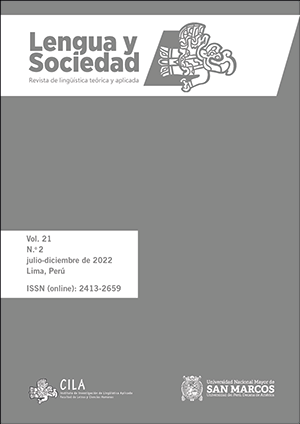Devoicing of Polish sibilant fricatives: the case of a speaker from Gdynia
DOI:
https://doi.org/10.15381/lengsoc.v21i2.22449Keywords:
Polish, sibilants, devoicing, linear model, autosegmental modelAbstract
In the present study, we analyze the devoicing of the sibilants /z/, /ʑ/ and /ʐ/ of a native speaker of Polish from the town of Gdynia. In the phonological analysis, we followed the linear model, proposed by Chomsky and Halle (1968), and the hierarchical autosegmental model of Nuñez-Cedeño (2014), both belonging to generative phonology. The results show that the devoicing of alveolar, alveopalatal and retroflex sibilants occurs in a) implosive position, followed by a voiceless obstruent, and b) at the end of the word. Likewise, the process of devoicing of the retroflex sibilant /ʐ/ was found when it is preceded by a voiceless occlusive. On the other hand, the analysis reports a condition in which the sequence of final voiced sibilant followed by a voiced occlusive would be necessary for sonority preservation. Finally, the observed processes are explained by the formulation of three phonological rules.
References
Boersma, P. y Weenink, D. (2022). Praat: doing phonetics by computer [Computer program]. Version 6.1.48. https://www.fon.hum.uva.nl/praat/
Chomsky, N. y Halle, M. (1979). Principios de fonología generativa (1a ed.). Editorial Fundamentos.
Crystal, D. (2000). Diccionario de lingüística y fonética. Editorial Octaedro.
Elías-Ulloa, J. (2011). Una documentación acústica de la lengua shipibo-conibo (pano) - con un bosquejo fonológico. Fondo Editorial PUCP. https://repositorio.pucp.edu.pe/index/handle/123456789/174304
Gil Fernández, J. (2005). Los sonidos del lenguaje. Editorial Síntesis.
Gussmann, E. (2007). The phonology of Polish. Oxford University Press.
Hamann, S. (2002). Postalveolar fricatives in Slavic languages as retroflexes. Universitätsbibliothek Johann Christian Senckenberg. https://citeseerx.ist.psu.edu/viewdoc/download?doi=10.1.1.213.339&rep=rep1&type=pdf
Haspelmath, M. y Sims, A. (2013). Understanding morphology. Routledge. https://www.taylorfrancis.com/books/mono/10.4324/9780203776506/understanding-morphology-martin-haspelmath-andrea-sims
Ibarra Valer, R. A. (2020). Sincronía y diacronía de los sonidos retroflejos del quechua huanca desde la fonética articulatoria. Lengua y Sociedad, 18(2), 59-79. https://doi.org/10.15381/lengsoc.v18i2.22329
Jassem, W. (2003). Polish. Journal of the International Phonetic Association, 33(1), 103-107. https://www.jstor.org/stable/i40190075
Jassem, W. y Richter, L. (1989). Neutralization of voicing in Polish obstruents. Journal of Phonetics, 17(4), 317-325. https://www.sciencedirect.com/science/article/pii/S0095447019304474
Lahoz-Bengoechea, J. (2015). Fonética y fonología de los fenómenos de refuerzo consonántico en el seno de unidades léxicas en español. Universidad Complutense, Madrid. https://eprints.ucm.es/id/eprint/40122/1/T38016.pdf
Ladefoged, P. y Maddieson, I. (1996). The Sounds of the World's Languages. Editorial Blackwell.
Martínez Celdrán, E. (1984). ¿Hasta qué punto es importante la sonoridad en la discriminación auditiva de las obstruyentes mates del castellano?. Estudios de fonética experimental, 1(1), p. 243-91. https://raco.cat/index.php/EFE/article/view/144193
Nuñez-Cedeño, R., Colina, S. y Bradley, T. (2014). Fonología generativa contemporánea de la lengua española. Georgetown University Press, Washington DC.
Slowiaczek, L., y Dinnsen, D. (1985). On the neutralizing status of Polish word-final devoicing. Journal of Phonetics, 13(3), 325-341. https://www.sciencedirect.com/science/article/pii/S0095447019307636
Slowiaczek, L., y Szymanska, H. (1989). Perception of word-final devoicing in Polish. Journal of Phonetics, 17(3), 205-212. https://www.sciencedirect.com/science/article/pii/S0095447019304309
Šimáčková, Š., Podlipský, V. J., y Chládková, K. (2012). Czech spoken in Bohemia and Moravia. Journal of the International Phonetic Association, 42(2), 225-232.
Stempek, I., Stelmach, A., Dawidek, S., Szymkiewicz, A. (2013). POLSKI krok po kroku 1. Polonia: Polish-courses.com.
Presa, F. (2008). Gramática polaca. Editorial Cátedra.
Zygis, M. (2003). Phonetic and phonological aspects of Slavic sibilant fricatives. ZAS papers in Linguistics, 32, 175-213. https://zaspil.leibniz-zas.de/article/view/191
Downloads
Published
Issue
Section
License
Copyright (c) 2022 Renzo Adrián Jiménez Bernales, Myluz Danithza Cano Anchorena, Patricia Rosa Emilia Chávez Ortiz, Samuel Elías Arenas Girón

This work is licensed under a Creative Commons Attribution 4.0 International License.
AUTHORS RETAIN THEIR RIGHTS
a. Authors retain their trade mark rights and patent, and also on any process or procedure described in the article.
b. Authors can submit to the journal Lengua y Sociedad, papers disseminated as pre-print in repositories. This should be made known in the cover letter.
c. Authors retain their right to share, copy, distribute, perform and publicly communicate their article (eg, to place their article in an institutional repository or publish it in a book), with an acknowledgment of its initial publication in the journal Lengua y Sociedad.
d. Authors retain theirs right to make a subsequent publication of their work, to use the article or any part thereof (eg a compilation of his papers, lecture notes, thesis, or a book), always indicating its initial publication in the journal Lengua y Sociedad (the originator of the work, journal, volume, number and date).






